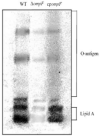Outer Membrane Protein F Is Involved in Biofilm Formation, Virulence and Antibiotic Resistance in Cronobacter sakazakii
- PMID: 34835462
- PMCID: PMC8619257
- DOI: 10.3390/microorganisms9112338
Outer Membrane Protein F Is Involved in Biofilm Formation, Virulence and Antibiotic Resistance in Cronobacter sakazakii
Abstract
In some Gram-negative bacteria, ompF encodes outer membrane protein F (OmpF), which is a cation-selective porin and is responsible for the passive transport of small molecules across the outer membrane. However, there are few reports about the functions of this gene in Cronobacter sakazakii. To investigate the role of ompF in detail, an ompF disruption strain (ΔompF) and a complementation strain (cpompF) were successfully obtained. We find that OmpF can affect the ability of biofilm formation in C. sakazakii. In addition, the variations in biofilm composition of C. sakazakii were examined using Raman spectroscopy analyses caused by knocking out ompF, and the result indicated that the levels of certain biofilm components, including lipopolysaccharide (LPS), were significantly decreased in the mutant (ΔompF). Then, SDS-PAGE was used to further analyze the LPS content, and the result showed that the LPS levels were significantly reduced in the absence of ompF. Therefore, we conclude that OmpF affects biofilm formation in C. sakazakii by reducing the amount of LPS. Furthermore, the ΔompF mutant showed decreased (2.7-fold) adhesion to and invasion of HCT-8 cells. In an antibiotic susceptibility analysis, the ΔompF mutant showed significantly smaller inhibition zones than the WT, indicating that OmpF had a positive effect on the influx of antibiotics into the cells. In summary, ompF plays a positive regulatory role in the biofilm formation and adhesion/invasion, which is achieved by regulating the amount of LPS, but is a negative regulator of antibiotic resistance in C. sakazakii.
Keywords: Cronobacter sakazakii; LPS; adhesion/invasion; biofilm formation; ompF.
Conflict of interest statement
The authors declare no conflict of interest.
Figures







Similar articles
-
A Negative Regulator of Cellulose Biosynthesis, bcsR, Affects Biofilm Formation, and Adhesion/Invasion Ability of Cronobacter sakazakii.Front Microbiol. 2017 Sep 26;8:1839. doi: 10.3389/fmicb.2017.01839. eCollection 2017. Front Microbiol. 2017. PMID: 29085341 Free PMC article.
-
Short communication: Roles of outer membrane protein W (OmpW) on survival and biofilm formation of Cronobacter sakazakii under neomycin sulfate stress.J Dairy Sci. 2018 Apr;101(4):2927-2931. doi: 10.3168/jds.2017-13517. Epub 2018 Feb 7. J Dairy Sci. 2018. PMID: 29428742
-
Outer membrane defect and stronger biofilm formation caused by inactivation of a gene encoding for heptosyltransferase I in Cronobacter sakazakii ATCC BAA-894.J Appl Microbiol. 2012 May;112(5):985-97. doi: 10.1111/j.1365-2672.2012.05263.x. Epub 2012 Mar 13. J Appl Microbiol. 2012. PMID: 22353600
-
Proteomics profiles of Cronobacter sakazakii and a fliF mutant: Adherence and invasion in mouse neuroblastoma cells.Microb Pathog. 2020 Dec;149:104595. doi: 10.1016/j.micpath.2020.104595. Epub 2020 Nov 4. Microb Pathog. 2020. PMID: 33157215 Review.
-
[Taxonomy and pathogenic mechanism of Cronobacter (Enterobacter sakazakii)--a review].Wei Sheng Wu Xue Bao. 2010 Jul;50(7):841-6. Wei Sheng Wu Xue Bao. 2010. PMID: 20815228 Review. Chinese.
Cited by
-
Antibiotic Resistance and Molecular Characterization of Cronobacter sakazakii Strains Isolated from Powdered Infant Formula Milk.Foods. 2022 Apr 11;11(8):1093. doi: 10.3390/foods11081093. Foods. 2022. PMID: 35454680 Free PMC article.
-
Effects of ESA_00986 Gene on Adhesion/Invasion and Virulence of Cronobacter sakazakii and Its Molecular Mechanism.Foods. 2023 Jun 30;12(13):2572. doi: 10.3390/foods12132572. Foods. 2023. PMID: 37444309 Free PMC article.
-
Cronobacter sakazakii Pyridoxal Kinase PdxY Mediated by TreR and pESA3 Is Essential for Vitamin B6 (PLP) Maintenance and Virulence.Appl Environ Microbiol. 2023 Aug 30;89(8):e0092423. doi: 10.1128/aem.00924-23. Epub 2023 Jul 17. Appl Environ Microbiol. 2023. PMID: 37458600 Free PMC article.
-
Antimicrobial photodynamic inactivation as an alternative approach to inhibit the growth of Cronobacter sakazakii by fine-tuning the activity of CpxRA two-component system.Front Microbiol. 2023 Jan 17;13:1063425. doi: 10.3389/fmicb.2022.1063425. eCollection 2022. Front Microbiol. 2023. PMID: 36733775 Free PMC article.
-
Biofilms as protective cocoons against biocides: from bacterial adaptation to One Health issues.Microbiology (Reading). 2023 Jun;169(6):001340. doi: 10.1099/mic.0.001340. Microbiology (Reading). 2023. PMID: 37266984 Free PMC article. Review.
References
Grants and funding
LinkOut - more resources
Full Text Sources
Molecular Biology Databases

